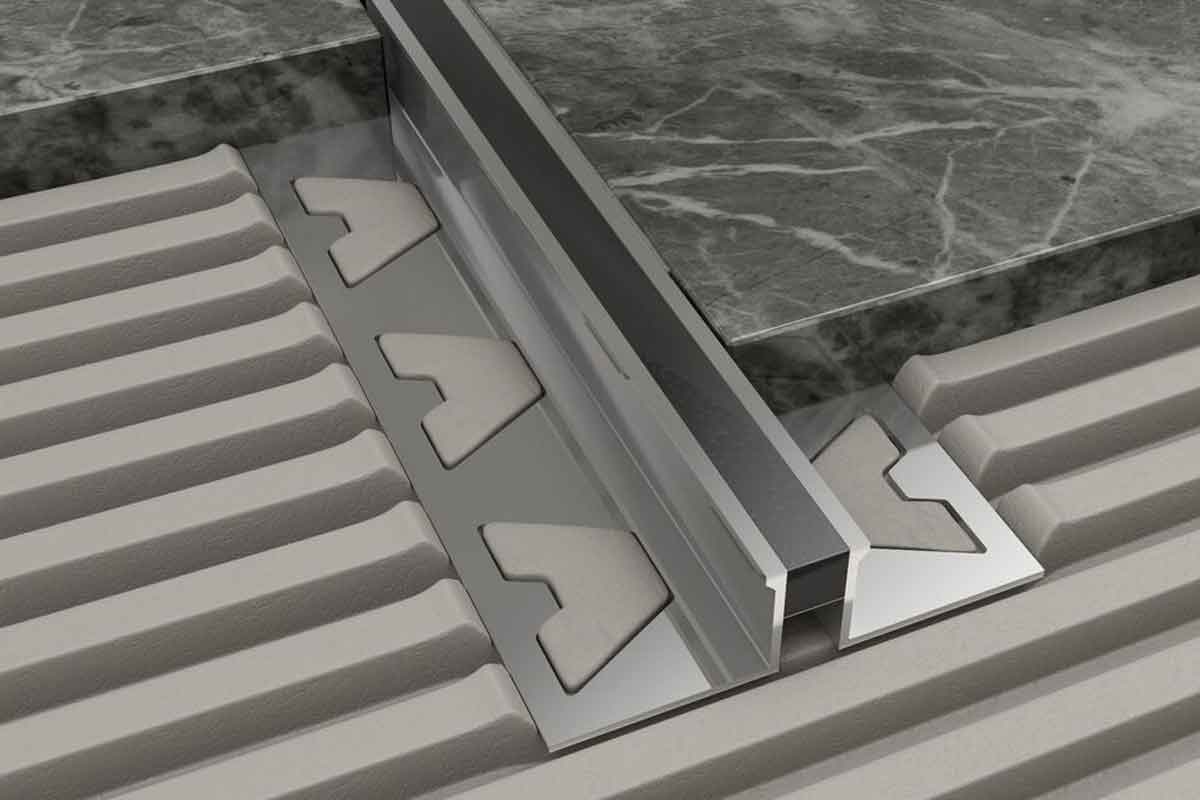
Movement joints are designed to separate large tiled areas into smaller tile fields, which are capable of absorbing movement between the substrate below and the tiled surface. By absorbing gradual movement, the joints will prevent cracks and debonding within the grout and tiles themselves. However, to ensure the movement joints provide the absorption required, it is essential to install them in the correct places.
Types of movement joints
Movement joints can be installed within both walls and floors, with movement profiles typically designed with PVC or metal legs that are connected to a synthetic movement area. This provides enough flexibility to allow for sufficient movement, whilst being robust enough to withstand potential conditions within the surface.
There are two types of joints, structural joints which pass through the tile, screed and floor slab, and non-structural joints which do not penetrate through to the slab. The non-structural movement joints are designed to allow for shrinkage of the floor slab below without damaging the tiles above. Whereas, structural joints are designed to absorb structural movement such as thermal expansion and contraction.
Structural and intermediate joint positioning
The exact positioning of movement joints should be assessed based on factors such as the type of flooring, the adhesive bed, the substrate and the magnitude of stresses, with the following being the key points to follow:
• The larger the tiled surface, the more stress it will be under, so the guidelines state that each tile field should be no larger than 10 metres by 10 metres.
• Most floor tile fields are usually between 5 and 8 metres wide in any direction, with further reductions in size for suspended floors.
• For large tiled walls, the movement joints should be installed between every 3 and 4.5 metres both vertically and horizontally, with all internal corners included.
• If a tiled surface is likely to be exposed to high degrees of thermal temperature changes, such as being exposed to direct sunlight or being installed above underfloor heating, the tile fields should be no larger than 40 sq. metres with no single length larger than 8 metres.
• Movement joints should also be installed above any existing movement joints, with the size being either the same width or wider than the existing joints.
Perimeter joint positioning
Perimeter joints are designed to separate the tiled area from walls, enclosures or structural elements. If these elements move, the perimeter joints will protect the tile covering by limiting forces from potential movement.
• For tiled areas which are less than 2m wide, there is no requirement to install perimeter joints unless large stresses are expected. However, they do contribute to acoustic insulation so we always advise using them where possible.
• Perimeter joints should be at least 6mm wide and they should reach through to the decoupling layer with a depth of more than 12mm.
• Perimeter joints can be located under the tile covering or skirting, with fill material used for a professional finish.
• The skirting or tile should be placed over the joint in a way which does not compromise the movement.
As you can see, there are multiple points to follow when installing these joints, with various profiles designed for specific applications. To ensure a professional finish it is important to choose the correct profiles based on the following considerations:
• The type of use – will it be subjected to light or heavy traffic
• Exposure to moisture and chemicals
• Expected movement
• The adhesive methods for the tile covering
The most common profiles are pre-formed with anchor legs that feature closely spaced punched out sections. These small sections are designed to enable the adhesive to lock the joint in place and to support the edges of the tile. If you are installing movement joints in high traffic areas, we always recommend using metal profiles, with aluminium, brass and stainless-steel joints readily available. If you are installing within a low traffic residential or light commercial zone, PVC profiles can be used.
Movement joints are an important part of every installation, especially if you are looking to guarantee a professional long-term installation. Although many customers may worry that movement joints will take away from the overall finish of the tiled surface, there are many stylish options available which provide a great design and complete installation peace of mind.
For more information about our trade range of movement joints or for more technical advice, please contact the Quantum team.

